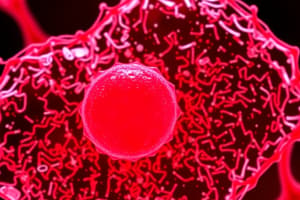Podcast
Questions and Answers
कोशिका की मुख्य संरचनात्मक और कार्यात्मक इकाई क्या है?
कोशिका की मुख्य संरचनात्मक और कार्यात्मक इकाई क्या है?
एन्डोप्लाज्मिक रेटिकुलम का मुख्य कार्य क्या है?
एन्डोप्लाज्मिक रेटिकुलम का मुख्य कार्य क्या है?
कोशिका में चयापचय की प्रक्रिया कहां होती है?
कोशिका में चयापचय की प्रक्रिया कहां होती है?
कोशिका विभाजन की प्रक्रिया में माइटोसिस का परिणाम क्या है?
कोशिका विभाजन की प्रक्रिया में माइटोसिस का परिणाम क्या है?
Signup and view all the answers
Lysosomes में क्या होता है?
Lysosomes में क्या होता है?
Signup and view all the answers
कोशिका में प्रोटीन संश्लेषण कहां होता है?
कोशिका में प्रोटीन संश्लेषण कहां होता है?
Signup and view all the answers
पासिव ट्रांसपोर्ट की प्रक्रिया में ऊर्जा की आवश्यकता होती है?
पासिव ट्रांसपोर्ट की प्रक्रिया में ऊर्जा की आवश्यकता होती है?
Signup and view all the answers
कोशिका में केंद्रक का मुख्य कार्य क्या है?
कोशिका में केंद्रक का मुख्य कार्य क्या है?
Signup and view all the answers
Study Notes
Cell Biology
Definition of Cell
- A cell is the basic structural and functional unit of living organisms.
- It is a self-contained system that carries out most of the chemical reactions necessary for life.
Cell Structure
- Plasma Membrane: Semi-permeable membrane that separates the cell from its environment.
- Cytoplasm: Jelly-like substance inside the cell where metabolic reactions take place.
- Nucleus: Control center of the cell where DNA is stored.
- Mitochondria: Organelles responsible for generating energy for the cell through cellular respiration.
- Endoplasmic Reticulum (ER): Network of membranous tubules and cisternae involved in protein synthesis, folding, and transport.
- Ribosomes: Small organelles found throughout the cytoplasm where protein synthesis takes place.
- Lysosomes: Membrane-bound sacs that contain digestive enzymes and help break down and recycle cellular waste.
Cell Functions
- Metabolism: The process of converting energy and nutrients into the components that make up living organisms.
- Growth and Development: The process of cell growth, differentiation, and specialization.
- Response to Stimuli: Cells respond to changes in their environment through signaling pathways and gene expression.
- Reproduction: Cells divide to produce new cells through mitosis and meiosis.
Cell Division
- Mitosis: The process of cell division that results in two daughter cells with the same number of chromosomes as the parent cell.
- Meiosis: The process of cell division that results in four daughter cells with half the number of chromosomes as the parent cell, occurring in reproductive cells.
Cell Transport
- Passive Transport: Movement of molecules from an area of high concentration to an area of low concentration without energy input (e.g., diffusion, osmosis).
- Active Transport: Movement of molecules from an area of low concentration to an area of high concentration with energy input (e.g., pumps, carrier proteins).
कोशिका जीव विज्ञान
कोशिका की परिभाषा
- जीवित जीवों की मूल संरचनात्मक और कार्यात्मक इकाई कोशिका है। * यह एक स्व-निहित प्रणाली है जो जीवन के लिए आवश्यक रासायनिक प्रतिक्रियाओं का संचालन करती है।
कोशिका संरचना
- प्लाज्मा झिल्ली: पर्यावरण से कोशिका को अलग करने वाली अर्ध-पारगम्य झिल्ली। * साइटोप्लाज्म: कोशिका के अंदर चिपचिपा पदार्थ जहाँ चय-apachaya प्रतिक्रियाएँ होती हैं। * नाभिक: कोशिका का नियंत्रण केंद्र जहाँ डीएनए संग्रहीत होता है। * माइटोकॉन्ड्रिया: कोशिका के लिए ऊर्जा उत्पन्न करने वाले अंग कोशिका श्वसन प्रक्रिया में। * एंडोप्लाज्मिक रेटिकुलम (ER): प्रोटीन संश्लेषण, मोड़ने और परिवहन में शामिल मेम्ब्रानोस ट्यूबुल्स और सिस्टरने का नेटवर्क। * रائبोसोम: साइटोप्लाज्म में फैले हुए छोटे अंग जहाँ प्रोटीन संश्लेषण होता है। * लाइसोसोम: कोशिकीय कचरा को तोड़ने और पुनः цикल करने में मदद करने वाले मेम्ब्रान बाउंड सैक्स।
कोशिका कार्य
- उपापचय: जीवित जीवों के घटकों में ऊर्जा और पोषक तत्वों का रूपांतरण प्रक्रिया। * वृद्धि और विकास: कोशिका वृद्धि, विभेदीकरण और विशेषीकरण प्रक्रिया। * उत्तेजना के प्रति प्रतिक्रिया: कोशिकाएँ पर्यावरण में परिवर्तन के लिए सिग्नलिंग पाथवे और जीन एक्सप्रेशन के माध्यम से प्रतिक्रिया करती हैं। * पुनरुत्पादन: कोशिकाएँ माइटोसिस और मiosis प्रक्रिया में नवीन कोशिकाएँ उत्पन्न करने के लिए विभाजित होती हैं।
कोशिका विभाजन
- माइटोसिस: कोशिका विभाजन की प्रक्रिया जिसके परिणामस्वरूप मातृ कोशिका के समान संख्या के क्रोमोसोम वाली दो पुत्री कोशिकाएँ उत्पन्न होती हैं। * मiosis: कोशिका विभाजन की प्रक्रिया जिसके परिणामस्वरूप मातृ कोशिका के आधे संख्या के क्रोमोसोम वाली चार पुत्री कोशिकाएँ उत्पन्न होती हैं, जो प्रजनन कोशिकाओं में होती है।
कोशिका परिवहन
- निष्क्रिय परिवहन: ऊर्जा इनपुट के बिना उच्च सांद्रता क्षेत्र से नीच सांद्रता क्षेत्र में अणुओं का परिवहन (जैसे विसरण, ओसмосिस)। * सक्रिय परिवहन: ऊर्जा इनपुट के साथ नीच सांद्रता क्षेत्र से उच्च सांद्रता क्षेत्र में अणुओं का परिवहन (जैसे पम्प, वाहक प्रोटीन)।
Studying That Suits You
Use AI to generate personalized quizzes and flashcards to suit your learning preferences.
Description
इस क्विज़ में細胞 जीव विज्ञान के बारे में पूछे गए प्रश्न शामिल हैं, जिसमें कोशिका की परिभाषा, कोशिका संरचना और इसके घटक शामिल हैं. यह क्विज़ 11वीं कक्षा के लिए उपयोगी है.




